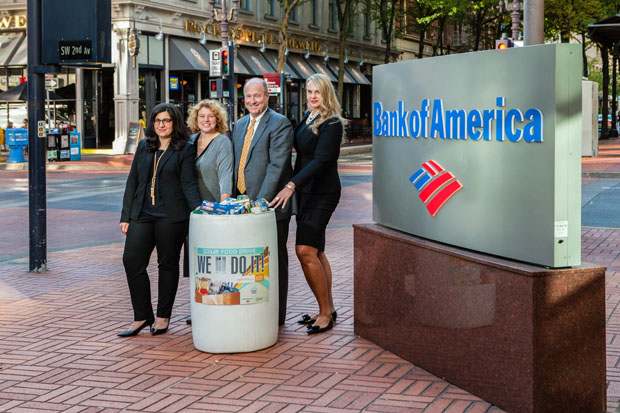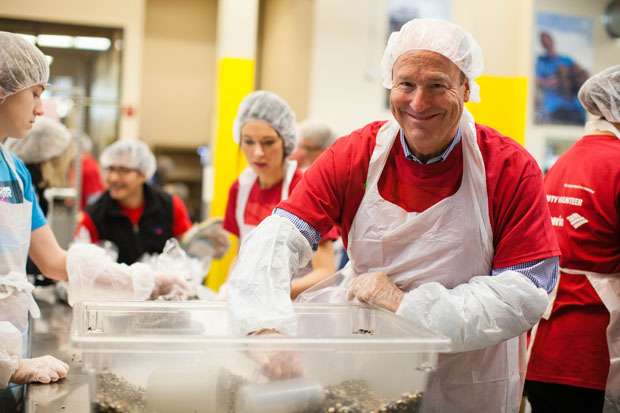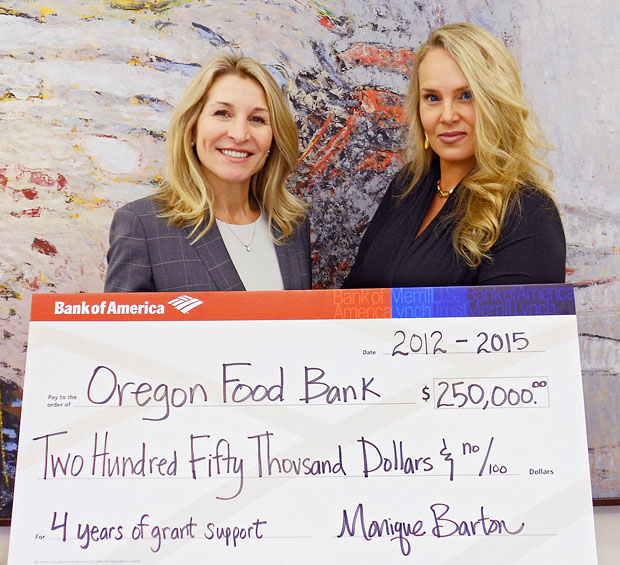BY STUART WATSON
Engaging employees and customers along the way.
BY STUART WATSON
Engaging employees and customers along the way

From left: Nicole Frisch, Bank of America Vice President, Corporate Social Responsibility; Susannah Morgan of Oregon Food Bank; Roger Hinshaw, Bank of America Oregon & SW Washington Market President; Monique Barton, Bank of America Senior Vice President, Corporate Social Responsibility
Alarmed in 2011 by the rising tide of hunger in Oregon and southwest Washington, regional executives for Bank of America could have taken the easy route.
They could have written a check. Or maybe put out collection barrels to collect canned food. Or perhaps encouraged employees to volunteer in community gardens. Or executed marketing tactics that highlight local food insecurity. Or organized large-scale community volunteer events.
It would have been relatively easy to do any one of those things. Yet Bank of America did all of the above — and more. Along the way, it learned some important lessons about how to address the hunger challenge in a strategic way, while also engaging employees and clients in the cause.
“Four years ago, Oregon had the fourth highest rate of household hunger in the country and that was shocking to me,” says Roger Hinshaw, the local market president for Bank of America. “Today, even with an improved economy, hunger remains a local epidemic. The fact is that 270,000 people receive emergency food boxes every month. A third are children. We’ve made progress, but there’s more to be done.”
Hinshaw says statistics like those led Bank of America to establish a deep partnership with Oregon Food Bank four years ago. And by design, the bank’s support went well beyond just writing a check.
“It has been a two-way partnership,” says Hinshaw. “It evolves every year.”

Susannah Morgan, executive director of the Food Bank, says tackling hunger requires big players to help make sure people have enough food today, move beyond need tomorrow and erase challenges that limit food access everywhere.
“Bank of America really stepped forward to be one of the key, mission-critical partners,” she says.
Monique Barton had just such a partnership in mind when Bank of America approached Oregon Food Bank. The bank’s senior vice president of corporate social responsibility, Barton agreed with Hinshaw and the bank’s local leadership team that the bank wanted to “go big” in their commitment to fighting hunger.
“Certainly a big part of our support to Oregon Food Bank has been financial,” says Barton. “In the past four years alone, we’ve donated more than $250,000 in grants and financial support. But all along, our plan was to layer in lots of additional elements of support, while creating awareness about hunger within the broader community.”
Barton says the bank has worked with KPTV, KINK radio and KGW-TV to build awareness that nearly one in six Oregonians struggles with hunger at some time during the year.
“This fall for example, we’ve had food donation bins in our Portland and Vancouver-area BofA branches, since our customers and clients love being a part of the solution,” Barton says. “They’re very supportive and always end up donating thousands of pounds of food for the cause each year.”
Nicole Frisch, the bank’s vice president of corporate social responsibility, took it a step further this year by creating a text-to-give option.
“Our clients often tell us they want to help beyond donating food,” she says. “Text-to-give lets people donate quickly and easily to Oregon Food Bank. Every donated dollar will buy three meals, so it’s a powerful way to help.”
Frisch also cites the bank’s partnership with KINK radio, in which the bank underwrites production of a CD each year featuring the work of local musicians. The CDs sell for $3 apiece at places like New Seasons and Haggen, and all proceeds go to the Food Bank, generating about $15,000 each year.
Beyond cash and food donations, the bank has also led efforts to increase volunteerism. For four years, Bank of America has encouraged people to help at Oregon Food Bank locations during MLK Day in January. The bank also underwrites the cost of the food that is packed on that day.
“Each year our local employees donate more than 20,000 hours of volunteer time to local nonprofit causes, and Oregon Food Bank is by far the largest recipient,” says Barton. “Taking that a step further by rallying the community-at-large to join us on MLK Day has been very rewarding.”
By jumping head-first into the hunger problem, Bank of America is trying to create a ripple effect, Hinshaw says. Excitement fills his voice when he shares how the bank’s efforts have inspired other local corporate funders to get involved, and how bank employees volunteering at the Food Bank have now enlisted family and friends to regularly volunteer.
“It’s tangible benefit,” Hinshaw says. “You can see at the end of the shift how much good you can do.”

Tara Kinateder of U.S. Trust and a board member of Oregon Food Bank and Monique Barton of Bank of America present Oregon Food Bank with financial support.
Oregon Food Bank’s Morgan appreciates the broad corporate support. In particular, she applauds Bank of America’s support for the Seed to Supper program, which helps lower-income people plant and grow their own gardens.
“We’ve also been engaging the community of gardeners to produce food for us, which generates nearly 200,000 pounds of produce a year,” Morgan says.
She points to the Fresh Alliance project, which BofA also supported financially. The project finds homes for food nearing the end of its shelf-life at 280 grocery stores around Oregon. The program also moves surplus fresh fruits and vegetables around the state, to diversify fresh food offered through its network of 21 regional food banks. Residents of northeastern Oregon, for instance, can enjoy southern Oregon pears, while southern Oregon food baskets might gain onions and potatoes from Pendleton.
Efforts by Oregon Food Bank and partners like Bank of America have dropped Oregon out of the top 20 hungriest states nationally.
Morgan says she loves the potential for nonprofits like Oregon Food Bank to create innovative solutions via partnerships with business and government. As one example, she points to an effort this summer to set up a cleaning line at canneries for produce that weren’t needed and would have otherwise gone to waste.
“We improvised a rinse-wash line, accepted green beans, had them lab tested, and found that with volunteer help, we can make use of millions of pounds of fresh beans and produce we couldn’t use before,” Morgan says.
With all that has been accomplished already, Hinshaw is committed to continuing the Bank of America’s efforts around hunger.
“It’s been exciting to see the levels of engagement by our employees and even our clients,” he says. “We truly value being part of the solution to help remove barriers that prevent local communities from thriving. Focusing on hunger is something everyone can relate to.” n

